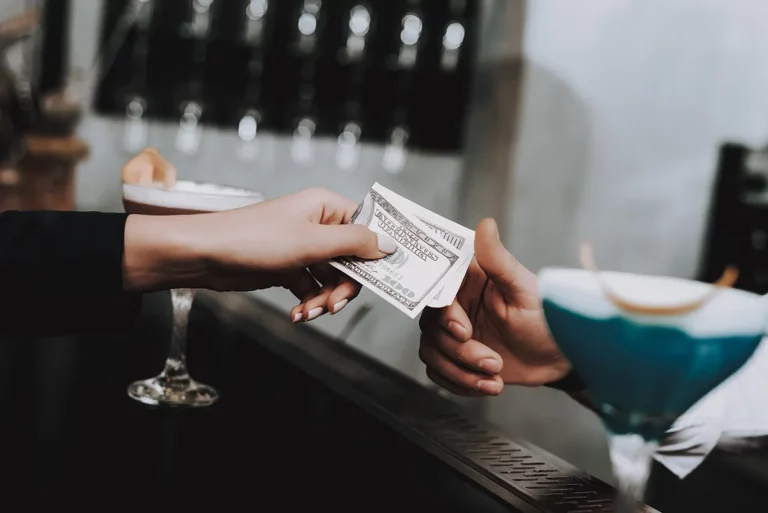After a long shift slinging cocktails, thinking about finances can feel like extra side work — no fun. But if you want to get your bank account in order, it’s essential to learn how to save money as a bartender.
No matter how unpredictable your income is, these practical tips will help you build financial security. Don’t miss the bonus tip (it’s on the house!) for saving money on peace of mind.
Tips for Bartenders Living Paycheck to Paycheck
Track Spending by Category for Three Months
How much do you spend every month?
Sneaky expenses can add up easily, and you might be surprised how much you dish out for ride-shares or subscription services. Track spending by category, such as rent, groceries, and “fun stuff,” to get a clear picture of how much money goes out regularly.
According to the most recent Bureau of Labor Statistics expenditure report, Americans spend about $500 a month on groceries. And that number just keeps increasing!
While you may not spend as much on your fridge restock, it’s important to get an accurate overview of your expenses. From there, assess where spending looks reasonable and where to cut back.
Create a Flexible Budget Based on Your Lowest-Earning Weeks
Sometimes you’re raking in killer tips. Other days, it seems like every other customer is stiffing you. No wonder it’s difficult to gauge how much you make on average!
To level up your bartender income planning, create a budget based on the lower end of your salary. It keeps the numbers reasonable and accounts for all the income variability that comes with working in the service industry.
- Track your base pay and tips received
- Identify the monthly average of your lowest-earning weeks
- Base your monthly expenses on this calculation
- Anything above = discretionary or savings
“Here’s what actually works: Start by tracking your income for about 3 months to find your ‘minimum reliable income’ — that’s your slowest possible week × 4. I had a client in Chicago who thought she made $4K monthly, but after tracking discovered her minimum was closer to $2.8K. That number became her baseline for fixed expenses.” – Andrew Lokenauth, Founder of BeFluentinFinance.com

Set Aside Tips Consistently
Whether you leave the bar with a fat stack of cash or your tips are added to your direct deposit bi-weekly, it’s easy to get into a lax “payday” mindset. The hard truth is you need to set aside a portion of your tips after every shift.
Physically or digitally allocating tips to savings right after clocking out is one of the smartest ways bartenders can manage irregular income. 10% of your tips is the minimum amount, but aim for 20% or higher if that works for your budget.
Consider cash tips “untrackable” income. It disappears with a takeout order here and a few coffees there. When you finally make it to the bank to deposit, you don’t even know how much cash you had to begin with.
- Do not spend your tips before tracking
- For cash, keep physical envelopes labeled for different savings goals
- For paycheck-integrated tips, set a reminder on payday to move part of your direct deposit to savings

Watch Your Social Spending
You know how it goes: after crushing a wedding or private event, the whole team heads to the usual joint to unwind. Dropping $50 on a nightcap, a bite of food, and a generous tip feels manageable. Do this twice a week for a year, and you’re losing out on $5,200 — enough to take you on vacation!
Working in the service industry is community-oriented, and the temptation to go out after a particularly harrowing gig is real. But if you want to save money as a bartender, cut down on social spending.
Try limiting your social outings to once a month, or setting a strict budget if you want to go more often.
Bartender Translation: Cut yourself off from frivolous spending!
Meal Prep Instead of Ordering Food
It can be tempting to run through a drive-thru after a late-night gig, but the cost of those quick meals can add up quickly. Instead of spending the extra cash, opt to meal prep.
Batch budget-friendly meals at home that can stretch across several days, like hearty soups or grain bowls. Having something ready to go when you’re tired or crunched for time makes it easier to resist the urge to order.
Over time, you’ll notice more money in your pocket. Saying no to a $10 bite each shift can save you $200 a month!
Start Thinking About Retirement Funds
Retirement planning for bartenders may feel like a distant concept, especially in a live-for-the-moment job like yours. But the earlier you start prepping for retirement, the better off you’ll be.
Consider options like IRAs or Roth IRAs that you can open independently and contribute to on your own schedule. Start small, then increase your contributions as your income grows.
- IRA (Individual Retirement Account): A savings account you set up for retirement. You don’t pay taxes on the money you put in right away, but you do pay taxes when you take the money out later in retirement.
- Roth IRA: Another type of savings account in which you pay taxes on the money now, and then your withdrawals in retirement are tax-free (including investment growth).
“Fo retirement, I typically recommend a Roth IRA for bartenders because of the tax advantages. Start with putting away just $100 monthly — that’s usually about one good shift’s worth of tips. I’ve watched several of my long-term clients build up $30K+ retirement accounts this way,” says Lokenauth.

Save Money With Monthly Bartender Insurance
Accidents happen — especially in a physically demanding and fast-paced job like bartending.
One of the best investment tips for bartenders is getting liability insurance. Whether it’s a chipped glass that injures a customer or an incident caused by an overserved guest, having this coverage in place keeps you from paying out of pocket to make things right.
Here’s the bonus tip: Monthly plans for bartender liability insurance are surprisingly affordable and can save you thousands of dollars in the long run by covering legal fees, medical bills, and settlements if you face a claim.
FLIP offers top-rated insurance for bartenders starting from $37.75 a month or $453 a year for an annual policy. The tradeoff for peace of mind is much lower than paying for an alcohol-related claim!
Ranked #1 for Liquor Liability Insurance by Investopedia
- A+ rated, affordable coverage
- Flexible payment options
- $2,000,000 aggregate limits for general and liquor liability
FAQs About Money Management Tips for Bartenders
What Type of Insurance Should Bartenders Consider?
At minimum, bartenders need:
- General liability insurance: Coverage for third-party bodily injury or property damage claims caused by your business operations, such as a customer slip-and-fall at the bar
- Liquor liability insurance: Protection for third-party liability claims involving those you serve alcohol to, such as an intoxicated guest causing an accident
FLIP bundles these core coverages to protect you from claims specific to your industry. The bartender insurance policy also includes optional coverages to fit your needs, like assault and battery coverage, professional liability, inland marine, and more!
What Type of Bartenders Make the Most Money?
High-end cocktail bartenders, event bartenders (like weddings or private parties), and those working in busy nightlife areas or luxury hotels tend to earn the most. It also depends on the geographical location, plus the bartender’s experience and charisma.
What Deductions Can Bartenders Claim on Their Taxes?
Self-employed bartenders can deduct work-related expenses like uniforms, mixology courses, and bar tools. Be sure to keep detailed records and work with a tax professional who understands your industry!

Alex Hastings
Seattle-based copywriter and (WA) licensed insurance agent Alex Hastings leverages her experience as a lover of fast-casual food, baked goods, and iced oat milk lattes. She holds a B.A. in Creative Writing from Western Washington University. Before working at Veracity, she was a retail copywriter at Zulily and an English language teacher in South Korea. Alex is fully trained on FLIP insurance coverages and writes content that connects food and beverage business owners with the policies they need.
Seattle-based copywriter and (WA) licensed insurance agent Alex Hastings leverages her experience as a lover of fast-casual food, baked goods, and iced oat milk lattes. She holds a B.A. in Creative Writing from Western Washington University. Before working at Veracity, she was a retail copywriter at Zulily and an English language teacher in South Korea. Alex is fully trained on FLIP insurance coverages and writes content that connects food and beverage business owners with the policies they need.

Kyle Jude
Kyle Jude is the Program Manager for Food Liability Insurance Program (FLIP). As a dedicated program manager with 10+ years of experience in the insurance industry, Kyle offers insight into different coverages for food and beverage business professionals who are looking to navigate business liability insurance.
Kyle Jude is the Program Manager for Food Liability Insurance Program (FLIP). As a dedicated program manager with 10+ years of experience in the insurance industry, Kyle offers insight into different coverages for food and beverage business professionals who are looking to navigate business liability insurance.

